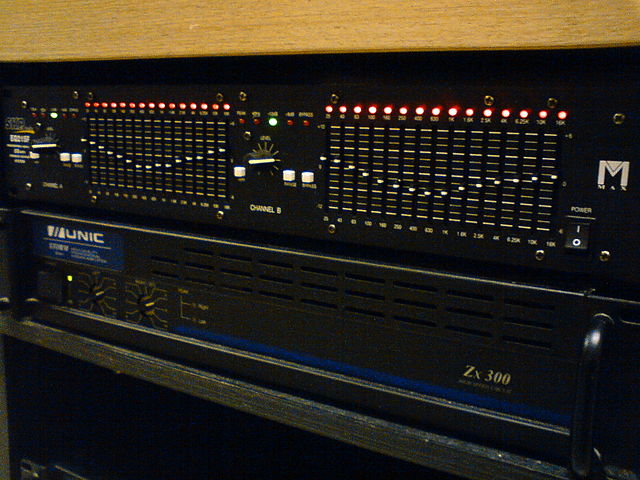This is the fourth in a series of posts documenting the development of Play With Your Music, a music production MOOC jointly presented by P2PU, NYU and MIT. See also the first, second and third posts.
After PWYM participants have tried mixing using just levels and panning, the next step is to include audio effects for additional audio manipulation. As a painless introduction, you can load any track from SoundCloud into our own miniature web-based effects unit, #PWYM Live Effects. Then it’s time to open up some dry stems in Soundation. In addition to mixing and panning, you can now do some creative application of Soundation’s effects. These include:
Both low-pass and high-pass filters are available, which block high and low frequencies, respectively. Why would you want to do such a thing? There are practical and expressive reasons. The practical one is to keep sounds from fighting each other in the mix. So, for example, my electric guitar has a very bass-heavy sound. If there’s a bassist on the track along with me, together we’re going to sound like mud. By applying a high-pass filter to my guitar, I can stay out of the bassist’s way and still get across most of the information in my sound. Similarly, I’d want to low-pass the bass for the same reason.
Filtering can also be used for special effects. Automating the cutoff frequency of the low-pass filter creates a hypnotic whooshing effect that sounds great in electronic music. Cutting out the high and low frequencies out of your voice makes you sound like you’re talking on the phone.
The most obvious way to add space to a recording is to apply reverb. You can apply a little, to get the feeling of a small room, or a lot, to get the feeling of a church or theater. Reverb can be used subtly to give the sound a little “audio Vaseline,” a softness around the edges, or it can be used more extremely to make the sound surreally distant.
This one seems simple on paper: it plays a copy of the incoming audio after a short time lag. You can get a surprising variety of musical effects from delay. A very small delay interval creates an artificial chorus sound, a fake version of multiple singers in unison. A slightly bigger interval gives you a “slapback,” the sound of a very quick reflection off a nearby surface. Longer delay intervals are a more science-fictional alternative to reverb — they create a feeling of space in a conspicuously artificial way. Current pop and dance music is likelier to use delay than reverb because it’s crisper and less diffuse. Unfortunately, Soundation doesn’t allow for my favorite use of delay, which is to tempo-sync it so that it returns its echoes on every quarter note, or dotted eighth note, or whatever. This adds a whole new rhythmic element to your song. If you’re willing to do some trial and error, you can manually tempo-sync your Soundation delays.
It has become fashionable to recreate the sound of low-quality digital samplers from the eighties. Degrader reduces the bit depth of your sound, introducing crunchy digital distortion effects.
This is a great way to get psychedelic whooshes and wobbles.
You most commonly encounter distortion on the electric guitar, which makes it sound harder, louder, more sustained, more loaded with overtones, and generally more rocking. It isn’t just for guitar, though; you can apply distortion to anything. Distorted vocals make you sound like you’re singing through a megaphone. Distorted keyboards sound like electric guitar. Distorted bass sounds like lower, scarier electric guitar. Distorted drums just generally sound amazing.
Compressor paradoxically makes things “louder” by making them quieter. If you make the loudest part of the signal quieter, then you can boost the overall volume without maxing out the volume and getting horrible clipping distortion. Compression is especially useful for making bass and vocals more prominent in the mix, but contemporary producers have a tendency to just use it on everything. This has led to the ongoing “loudness war,” where everybody uses more and more compression to get their track sounding louder than everyone else’s, leading to a lot of ear fatigue in the hapless listener.
EQ, as it’s known, is the more general version of the filter. Instead of simply chopping off the higher and lower frequencies, EQ lets you selectively cut and boost different parts of the frequency spectrum. You can use subtle EQ to make fine sonic adjustments, or extreme EQ for special effects akin to the filter. The difference between an okay-sounding mix and a really great one very often comes down to careful use of EQ. The best thing to do is a lot of experimentation.
A specialized version of the compressor that puts an upper ceiling on loudness. That keeps your peaks from clipping out without altering the sound too much. It’s a good idea to put limiter on your master channel, though expert audio engineers consider this to be a lazy technique — ideally you’d be managing your tracks’ loudness by hand.
The assignment, then, is to create a mix in Soundation, then post it to SoundCloud, along with a narrative description of the process behind it.
Next post: audio and MIDI editing.







